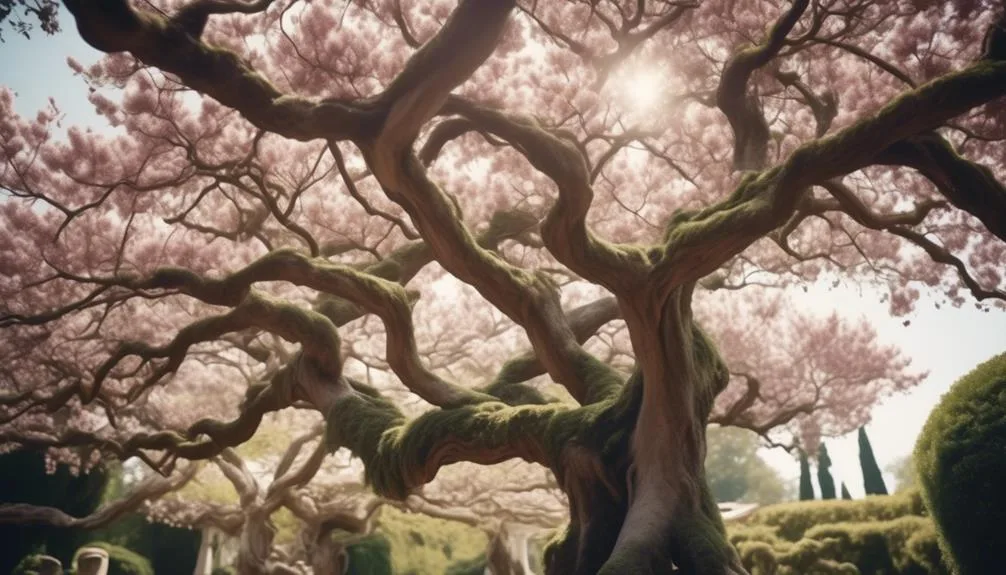The oldest magnolia trees in the world can be found in unexpected places, like the Southern United States' grand estates and botanical gardens. These majestic trees have silently witnessed centuries of history.
But where exactly can you find them? The answer might surprise you.
Exploring these ancient botanical wonders offers a glimpse into their enduring legacy and a fascinating journey to the past.
Southern United States
The Southern United States is home to some of the oldest and most majestic magnolia trees in the world. These iconic trees can be identified by their large, glossy leaves and fragrant, showy flowers. The sheer size and age of these magnolias make them a sight to behold, with some specimens dating back hundreds of years.
Conservation efforts in the region have focused on preserving these ancient trees, recognizing their cultural and ecological significance. Many organizations are working tirelessly to protect and propagate these magnificent trees, ensuring that future generations can continue to experience their beauty.
As you explore the Southern United States, keep an eye out for these remarkable magnolias, and consider supporting the conservation initiatives aimed at safeguarding these natural treasures.
Botanical Gardens
Nestled within the lush landscapes of the Southern United States, you'll discover botanical gardens showcasing an exquisite array of flora, including magnificent magnolia trees. These gardens are not only a feast for the eyes but also play a crucial role in conservation efforts and scientific research. Here's a glimpse of what you might find in these botanical wonderlands:
| Magnolia Variety | Height (in feet) | Blooming Season | Location |
|---|---|---|---|
| Grandiflora | 80 | Late Spring | Georgia |
| Virginiana | 60 | Summer | Virginia |
| D.D. Blanchard | 90 | Early Summer | Louisiana |
These botanical gardens serve as living laboratories, contributing to scientific research on plant biology, ecology, and botanical conservation. By visiting these gardens, you not only witness the beauty of the oldest magnolia trees but also support their preservation for future generations.
Historic Estates
Amidst the Southern United States' botanical gardens, the allure of historic estates beckons with their rich heritage and storied past. These estates stand as testaments to historic preservation and tree conservation, offering a glimpse into the region's rich history and the significant role trees have played in shaping it.
Many of these estates feature ancient magnolia trees, some dating back centuries, adding to the allure of these magnificent properties. Walking through the meticulously preserved grounds, you'll find yourself transported to a time when these trees were mere saplings, witnessing the dedicated efforts of generations past to protect and nurture them.
The marriage of historic preservation and tree conservation in these estates serves as a reminder of the importance of honoring the past while safeguarding the natural beauty that surrounds us.
Public Parks
At the heart of the city lies a sprawling public park, where vibrant flora and recreational activities come together to create a welcoming oasis for locals and visitors alike.
As you stroll through the park's winding pathways, keep an eye out for the magnificent magnolia trees that grace the landscape. You can easily identify these ancient beauties by their large, fragrant blossoms and glossy, dark green leaves.
The park plays a crucial role in magnolia conservation, providing a nurturing environment for these majestic trees to thrive. Take a moment to appreciate the significance of these living relics and the efforts taken to preserve them.
With tree identification guides available, you can deepen your understanding of the various magnolia species and their unique characteristics, adding a fascinating layer to your park experience.
Natural Reserves
As you explore the city's natural reserves, the ancient magnolia trees that have thrived in the public parks serve as a captivating reminder of the area's rich biodiversity and the importance of preserving such treasures. The natural reserves are crucial for the conservation efforts and tree preservation. These reserves provide a sanctuary for various flora and fauna, including the oldest magnolia trees in the world. Through dedicated conservation efforts, these natural reserves aim to protect the delicate ecosystems and ensure the survival of these remarkable trees for future generations to admire. By actively participating in tree preservation initiatives and supporting the conservation efforts within these reserves, you contribute to safeguarding the legacy of these majestic magnolia trees and the diverse wildlife that call these natural havens home.
| Natural Reserves | Importance |
|---|---|
| Biodiversity | Preservation |
| Conservation Efforts | Tree Preservation |
| Wildlife Sanctuary | Ecosystem Protection |
| Historical Significance | Future Generations |
| Ecological Balance | Environmental Sustainability |
Conclusion
Next time you stroll through the South's estates, botanical gardens, or public parks, take a moment to admire the enduring magnolia trees.
These ancient giants offer a glimpse into the rich natural history of these iconic trees. Witnessing these living treasures firsthand is a chance to connect with the timeless beauty of nature.

My interest in trees started when I first saw the giant sequoias in Yosemite.
I was a teenager then, and I remember thinking, “I need to learn more about this.”
That moment stuck with me.
A few years later, I went on to study forestry at Michigan Tech.
Since graduating, I’ve worked in a mix of hands-on tree care and community education.
I’ve spent over ten years helping people understand how to plant, maintain, and protect the trees in their neighborhoods.
I don’t see trees as just part of the landscape.
They are living things that make a real difference in our daily lives.
